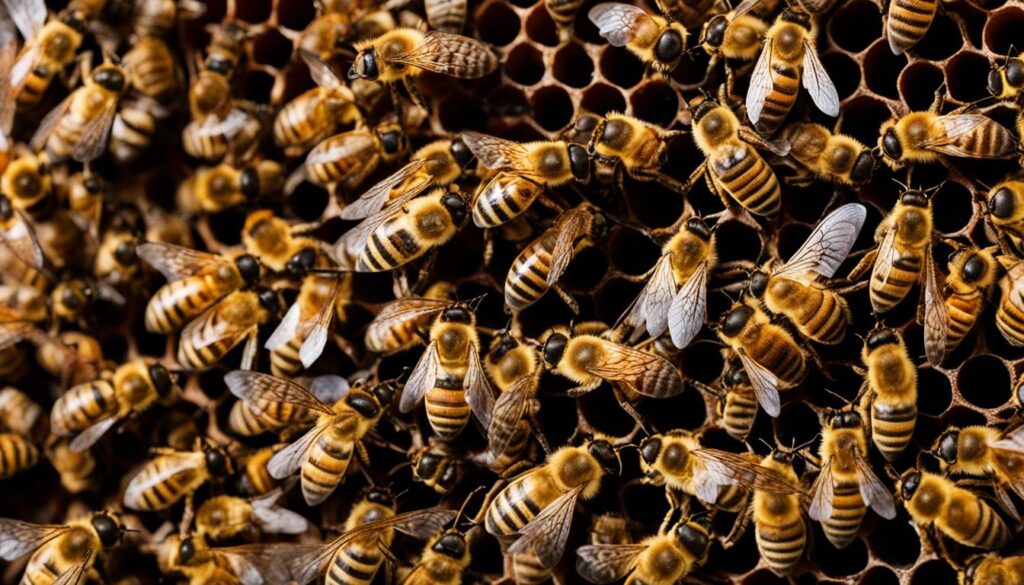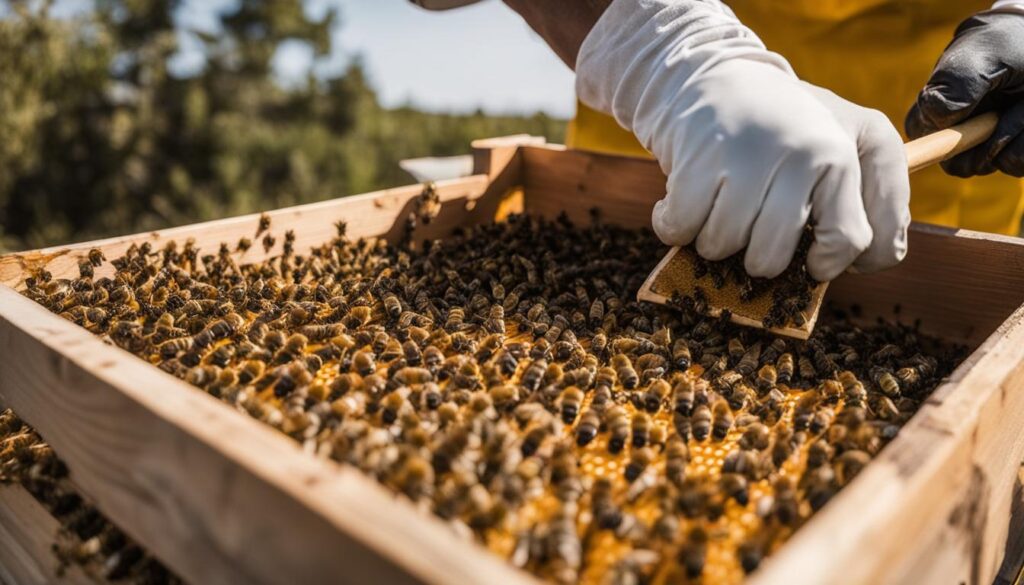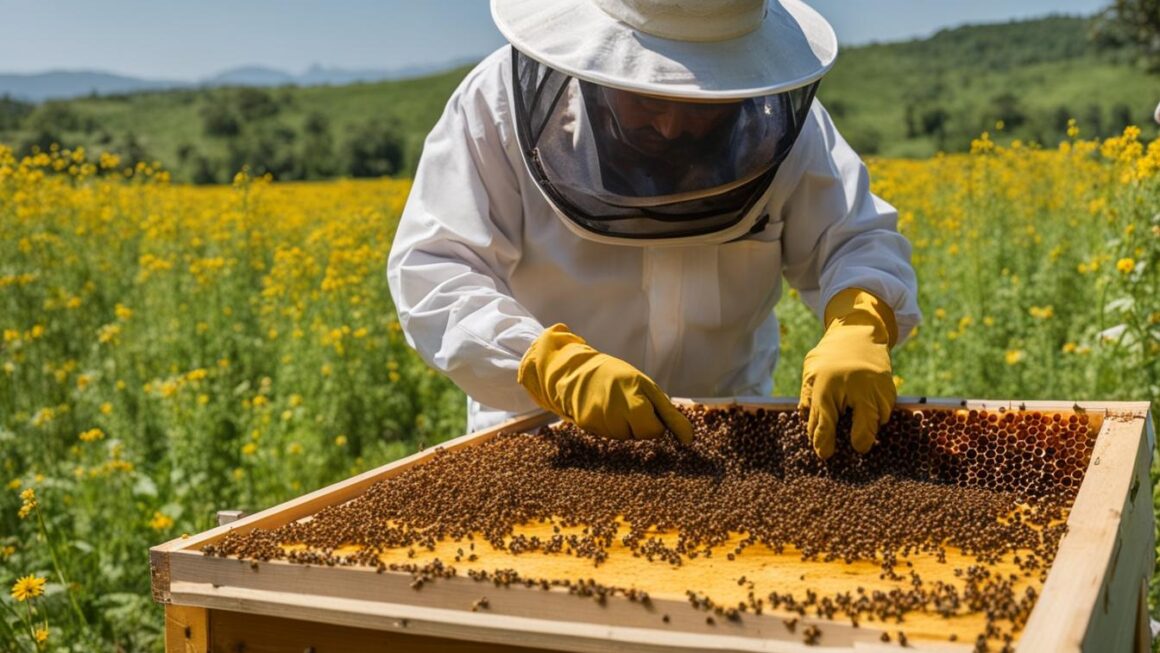Beekeeping is a rewarding and fulfilling hobby that offers not just the sweet taste of honey but also personal growth and self-improvement. However, like any endeavor, beekeepers face various challenges along the way. From stings and insect infestations to resistance in urban areas and the art of honey collection, navigating these hurdles requires resilience, problem-solving, and perseverance.
Overcoming obstacles in beekeeping is key to achieving success. By setting goals, seeking solutions, and learning from experienced beekeepers, you can turn challenges into opportunities for growth. Whether you are a new beekeeper or have years of experience, there are practical strategies and techniques to overcome these challenges and flourish in your beekeeping journey.
Key Takeaways:
- Be prepared to face obstacles in beekeeping, such as stings, infestations, and urban resistance.
- Wear protective gear, avoid perfumes, and use smoke to navigate stings.
- Maintaining hive health through regular inspections and seeking guidance from experienced beekeepers is crucial.
- Educating neighbors, following regulations, and considering rural relocation can help overcome urban area resistance.
- Perseverance, problem-solving, and learning from failures are essential in beekeeping.
Navigating Stings: Beekeeping Safety Tips
When it comes to beekeeping, safety is of utmost importance. Beekeepers must be aware of the potential risks and take necessary precautions to minimize the chances of getting stung. Here are some essential beekeeping safety tips to help navigate stings and ensure a safe and enjoyable beekeeping experience.
Wearing Protective Gear
One of the best ways to protect yourself from bee stings is by wearing appropriate protective gear. A bee suit, bee veil, and canvas gloves are essential items for beekeepers. These items create a physical barrier between the beekeeper and the bees, reducing the risk of stings. It is important to ensure that the protective gear is in good condition and properly worn during hive inspections and honey collection.
Avoiding Perfumes
Bees are highly sensitive to smells, especially strong scents like perfumes or colognes. These scents can attract bees and increase the likelihood of getting stung. When working with bees, it is advisable to avoid wearing perfumes or any scented products. Opt for unscented hygiene products and clothing to minimize the chances of attracting bees.
Using Smoke to Calm Bees
Smoke is a useful tool in beekeeping as it helps calm bees during hive inspections. When beekeepers introduce smoke into the hive, it triggers a response in the bees that makes them believe there may be a fire nearby. As a result, they start consuming honey, which makes them less defensive and more focused on preserving their food. By using a bee smoker, beekeepers can work with the bees more easily and reduce the risk of stings.
Getting Used to Each Other
Over time, bees become accustomed to the presence of their beekeeper. By working with the bees regularly and remaining calm and gentle, beekeepers can establish a sense of trust and familiarity with their colonies. Bees are less likely to sting when they perceive the beekeeper as a non-threatening presence. Developing a mutual understanding and respect between the beekeeper and the bees is crucial for minimizing stings and maintaining a harmonious beekeeping environment.
Dealing with Insect Infestation
Beekeepers often encounter challenges when it comes to insect infestation in their hives. Two common pests that can cause significant harm to bee colonies are mites and wax moths. Mites, such as Varroa destructor, can weaken and eventually kill the bees by feeding on their hemolymph, transmitting viruses, and causing deformities. Wax moths, on the other hand, infest the brood comb and destroy the wax, impacting the bees’ ability to rear healthy brood.
To combat these infestations, regular hive maintenance is essential. This includes inspecting the hives, monitoring for signs of infestation, and taking appropriate preventive measures. For mite control, beekeepers can utilize various treatment methods, such as organic acids, essential oils, and synthetic chemical options. Implementing a mite management plan, in consultation with experienced beekeepers, can help maintain healthy mite levels within the hive.
When it comes to dealing with wax moths, good hive management practices are crucial. It is important to keep the hive clean, remove any debris, and ensure proper storage of comb frames. Freezing or heating the combs can also be effective in controlling wax moth larvae. Seeking guidance from experienced beekeepers who have successfully managed these infestations can provide invaluable insights and tips.
| Insect Infestation Prevention Tips | Control Methods |
|---|---|
| Regularly inspect hives for signs of infestation | Utilize treatment methods like organic acids, essential oils, or synthetic chemicals |
| Maintain clean hives and remove debris | Freeze or heat combs to control wax moth larvae |
| Implement a mite management plan | Seek guidance from experienced beekeepers |
By staying vigilant and taking proactive measures, beekeepers can prevent and manage insect infestations effectively, ensuring the health and well-being of their bee colonies.
Ensuring Colony Health and Well-being
Beekeeping requires careful attention to the health and well-being of the colonies. Bees can suffer from various diseases and health issues, and it is important for beekeepers to be proactive in maintaining healthy colonies. Seeking advice from experienced beekeepers can provide valuable insights and guidance to diagnose and treat bee illnesses effectively.
Regular hive inspections are crucial in monitoring the overall health of the colony. By observing the behavior and appearance of the bees, beekeepers can identify any signs of disease or distress. It is essential to stay vigilant and address any issues promptly to prevent the spread of diseases and ensure the long-term well-being of the bees.
Additionally, practicing good hygiene and sanitation in the apiary can help maintain healthy colonies. This includes keeping the hive clean, removing any dead bees or debris, and regularly replacing old or damaged comb. Proper nutrition is also crucial, as bees require a balanced diet to thrive. Beekeepers can provide supplemental feeding when necessary, ensuring the bees have access to a diverse range of flowers and pollen sources.
Promoting Colony Health Through Integrated Pest Management
Integrated Pest Management (IPM) is a holistic approach to pest control that focuses on prevention and minimizing the use of chemical treatments. Implementing IPM strategies can help beekeepers manage common pests, such as Varroa mites and wax moths, while minimizing the impact on the bees and the environment. This approach involves regular monitoring, early detection of pests, and employing cultural, biological, and mechanical control methods.
Table:
| Pest | Description | Control Methods |
|---|---|---|
| Varroa mites | Parasitic mites that weaken and transmit diseases to bees | Use of screened bottom boards, drone brood trapping, organic acids |
| Wax moths | Insects that destroy brood comb, wax, and honey | Regular hive inspections, freezing or heat treatment of infested equipment |
| Small hive beetles | Insects that damage brood and contaminate honey | Proper hive maintenance, frequent hive inspections, beetle traps |
By implementing IPM practices and seeking advice from experienced beekeepers, beekeepers can effectively manage pests and diseases, ensuring the health and longevity of their colonies.
Overcoming Urban Area Resistance
Beekeeping in urban areas can often face resistance from neighbors who may not be comfortable with the idea of keeping bees nearby. However, there are several strategies that beekeepers can employ to overcome this resistance and create a harmonious relationship with their neighbors.
Educating Neighbors
One of the key ways to address urban area resistance is by educating neighbors about bees and their behavior. By explaining the importance of bees in pollination and the benefits of beekeeping, beekeepers can help foster understanding and dispel any misconceptions or fears. Providing educational materials or hosting community workshops can also be effective in building awareness and support.
Moving to Rural Areas
In some cases, beekeepers may choose to move their hives to rural areas away from densely populated neighborhoods. This could involve finding suitable land in agricultural areas or collaborating with local farmers who are open to hosting beehives on their properties. Moving to a rural environment can provide a more suitable setting for beekeeping and alleviate concerns of urban area residents.
Following Beekeeping Regulations
Adhering to beekeeping regulations is vital when keeping bees in urban areas. It is important to understand and comply with local ordinances and obtain any necessary permits or licenses. By demonstrating a commitment to responsible beekeeping practices and being in compliance with the law, beekeepers can help alleviate any concerns and build trust within the community.
By educating neighbors, considering a move to rural areas, and following beekeeping regulations, beekeepers can navigate the challenges of urban area resistance and create a positive environment for their bees and their community.

Table: Advantages and Disadvantages of Urban and Rural Beekeeping
| Advantages | Disadvantages | |
|---|---|---|
| Urban Beekeeping | – Access to a diverse range of pollen and nectar sources – Potential for higher honey yields – Opportunity to educate and engage local community members |
– Potential resistance from neighbors – Limited space for hive expansion – Higher risk of exposure to pesticides |
| Rural Beekeeping | – Abundance of natural forage – Greater space for hive expansion – Less exposure to urban pollutants and pesticides |
– Limited access to diverse nectar and pollen sources – Potential for lower honey yields – Distance from urban markets |
Perseverance and Persistence in Beekeeping
Beekeeping is a challenging and rewarding endeavor that requires perseverance and persistence. As with any pursuit, it’s important for beekeepers not to give up, even in the face of initial failures. Learning from these setbacks and trying again can lead to valuable insights and ultimately, success in beekeeping.
One of the key aspects of perseverance in beekeeping is the willingness to learn from failures. Each setback presents an opportunity to analyze what went wrong and make improvements. By identifying and addressing the causes of failure, beekeepers can refine their techniques and approach, increasing the chances of success in subsequent attempts.
Another important aspect of perseverance is the ability to learn from other beekeepers. Connecting with experienced beekeepers can provide valuable guidance, advice, and support. Hearing about their own challenges, failures, and successes can offer valuable lessons that can be applied to one’s own beekeeping journey. Building a network of supportive fellow beekeepers can provide motivation, inspiration, and a sense of community.
Insights from Experienced Beekeepers
In the words of beekeeping expert, John Smith: “Beekeeping is a journey that requires commitment and persistence. Don’t be discouraged by setbacks, as they are opportunities for growth. Learn from your mistakes, seek advice from experienced beekeepers, and keep trying. With time and dedication, you will become a successful beekeeper.”
To summarize, perseverance and persistence are essential for success in beekeeping. By not giving up, learning from failures, trying again, and connecting with other beekeepers, beekeepers can overcome challenges and achieve their goals. The path to becoming a successful beekeeper may be challenging, but with determination and a positive mindset, it can be a truly rewarding experience.
Catching and Managing Bee Swarms
One of the benefits of beekeeping is the opportunity to increase hive numbers by catching bee swarms. Swarms are the natural way that honey bees reproduce and form new colonies. Catching swarms not only helps beekeepers expand their apiaries but also contributes to the overall health and biodiversity of the local bee population. It’s a win-win situation for both beekeepers and the environment.

When a swarm is spotted, beekeepers can take advantage of the bees’ calm behavior during this time. Swarming bees are less likely to sting as they are focused on finding a suitable location to establish their new hive. Beekeepers can safely and gently capture the swarm, usually by guiding them into a specially designed box or hive.
Catching swarms not only allows beekeepers to increase their hive numbers but also provides an opportunity to learn from other experienced beekeepers. By connecting with the beekeeping community, beekeepers can gain valuable insights, tips, and techniques for successfully managing and nurturing their new swarms. Learning from others who have dealt with similar situations can greatly benefit novice beekeepers and enhance their chances of success.
Table: Benefits of Catching Bee Swarms
| Benefits | Description |
|---|---|
| Increased Hive Numbers | Catching bee swarms allows beekeepers to expand their apiaries and increase the number of productive hives. |
| Biodiversity | By catching swarms, beekeepers contribute to the preservation of bee populations and the overall health of the ecosystem. |
| Learning Opportunities | Connecting with experienced beekeepers while catching swarms provides novice beekeepers with valuable insights and techniques for successful beekeeping. |
Overall, catching and managing bee swarms is an important aspect of beekeeping. It allows beekeepers to increase hive numbers, support bee population health, and learn from experienced practitioners. By embracing this opportunity, beekeepers can continue to thrive in their beekeeping endeavors.
Collecting Honey without Upsetting Bees
Collecting honey from hives is a delicate process that requires careful consideration and bee-friendly techniques. Beekeepers must handle honey boxes with precision and minimize disruption to ensure the safety and well-being of both themselves and the bees. By following a few essential practices, honey collection can be a smooth and harmonious experience.
When approaching the hive for honey extraction, it is crucial to remain calm and gentle. Bees are highly sensitive to vibrations and sudden movements, which can agitate them and increase the likelihood of stings. Using slow and deliberate motions while handling the honey boxes can help maintain a peaceful environment.
Before removing the honey boxes, it is advisable to use a bee brush to gently sweep off any bees that may be clinging to the frames. This allows for better visibility and minimizes the chance of accidentally harming the bees. It is important to note that bees play a vital role in the pollination process, so care should be taken to ensure their well-being throughout the honey collection process.
Table: Bee-Friendly Techniques for Honey Collection
| Technique | Description |
|---|---|
| Use a bee brush | Gently sweep bees off the frames before removing the honey boxes to minimize disruption. |
| Utilize a fume board | Apply a fume board with a bee-repelling substance to encourage bees to move away from the honey boxes. |
| Perform honey extraction during calm weather | Choose a clear and calm day for honey collection to keep the bees calm and avoid potential flight disruptions. |
| Wear protective clothing | Utilize a bee suit, veil, and gloves to reduce the risk of stings and protect against bee aggression. |
Another effective technique is the use of a fume board. Placing a fume board with a bee-repelling substance, such as a specific odor or chemical, on top of the hive can encourage the bees to move away from the honey boxes. This allows for easier access to the honey without disturbing the bees unnecessarily.
Timing is also crucial when collecting honey. It is advisable to choose a clear and calm day for honey extraction. Bees are more likely to remain calm and less aggressive during favorable weather conditions, minimizing the risk of disturbances or flight disruptions.
Lastly, wearing protective clothing is essential to ensure personal safety and reduce the risk of stings. A bee suit, veil, and gloves provide a layer of protection against bee aggression, allowing beekeepers to work confidently and without fear.
Mastering Beekeeping Equipment
In order to be successful in beekeeping, it is essential to master the proper usage of beekeeping equipment and tools. This includes understanding how to use equipment such as smokers, hive tools, and bee brushes effectively and safely. By having a good grasp of these tools, beekeepers can ensure efficient and smooth beekeeping practices.
One of the most important pieces of beekeeping equipment is the smoker. The smoker is used to produce smoke, which has a calming effect on the bees. It allows beekeepers to work with the bees without agitating or alarming them. Learning how to properly operate the smoker, controlling the amount and direction of the smoke, is crucial for maintaining a calm and manageable atmosphere in the beehive.
Another essential tool in beekeeping is the hive tool. This versatile tool is used for various tasks, such as prying open hive boxes, removing frames, and scraping propolis or wax. Beekeepers should familiarize themselves with the different types of hive tools available and learn how to use them safely and effectively, taking care not to cause damage to the hive.

Beekeeping Equipment: Key Considerations
When choosing and using beekeeping equipment, it is important to consider factors such as durability, ease of use, and compatibility with beekeeping practices. Beekeepers should opt for high-quality equipment that will withstand the demands of beekeeping and ensure longevity. Additionally, ergonomic designs can make equipment more comfortable to handle for extended periods, reducing strain on beekeepers.
Furthermore, it is essential to keep beekeeping equipment clean and properly maintained. Regular cleaning and inspection of equipment help prevent the spread of diseases and maintain optimal conditions for bee colonies. Beekeepers should also regularly check and replace worn-out or damaged equipment to ensure the safety and well-being of their bees.
| Equipment | Function |
|---|---|
| Smoker | Produces smoke to calm bees |
| Hive Tool | Used for various tasks such as prying open hive boxes and removing frames |
| Bee Brush | Removes bees from frames and clears excess beeswax |
Mastering beekeeping equipment is an essential aspect of successful beekeeping. By learning how to use tools like smokers, hive tools, and bee brushes, beekeepers can effectively manage and care for their bee colonies, ensuring the well-being of the bees and the productivity of the hive.
Conclusion
Beekeeping can be a challenging yet immensely rewarding endeavor. Despite the hurdles that beekeepers face, there are effective solutions to address these challenges and achieve success in beekeeping. By persevering through stings, insect infestations, and colony health issues, beekeepers can navigate the difficulties and experience the joy of successful beekeeping.
One of the key factors in overcoming these challenges is seeking advice and support from experienced beekeepers. Their guidance can help beekeepers effectively manage insect infestations, diagnose bee diseases, and learn bee-friendly techniques for honey collection. The beekeeping community provides a wealth of knowledge and support, making it an invaluable resource for novice and seasoned beekeepers alike.
Through resilience and perseverance, beekeepers can turn failures into learning opportunities and continue to improve their beekeeping skills. Whether it’s catching swarms, mastering beekeeping equipment, or educating neighbors in urban areas, each challenge presents an opportunity for growth and personal development.
By addressing these common hurdles and implementing effective solutions, beekeepers can navigate the difficulties and achieve a successful beekeeping experience. With passion, dedication, and the support of the beekeeping community, beekeepers can overcome obstacles and enjoy the sweet rewards of their beekeeping journey.
FAQ
What are some safety tips for beekeeping?
Beekeepers can reduce the risk of stings by wearing protective gear, such as a bee suit, bee veil, and gloves. It’s important to avoid wearing perfumes that can attract bees or irritate them. Bees are also less likely to sting when beekeepers wear tan or white clothing. Using smoke can calm the bees and allow beekeepers to work with confidence. Over time, bees become accustomed to the beekeeper, reducing the likelihood of stings.
How can beekeepers deal with insect infestations in their hives?
Beekeepers need to regularly maintain their hives to control insect infestations. Mites can weaken and kill hives, while wax moths destroy the brood comb. Seeking guidance from experienced beekeepers can help identify and address these infestations effectively.
What should beekeepers do to ensure the health and well-being of their colonies?
Bees can suffer from various diseases and health issues. New beekeepers may not be familiar with these problems, but seeking advice from experienced beekeepers can help in diagnosing and treating bee illnesses. Taking proper measures to maintain healthy colonies is crucial for the overall well-being of the bees.
How can beekeepers overcome resistance from neighbors in urban areas?
Beekeeping in urban areas can face resistance from neighbors who may not be comfortable with bees. Educating neighbors about bees and their behavior can help ensure safety and understanding. In some cases, moving to rural areas away from populated areas may be an option. It’s important to also follow local regulations and obtain any necessary permits for beekeeping in urban areas.
What is the key to success in beekeeping?
Beekeeping, like any endeavor, requires perseverance and persistence. It’s important not to give up, even in the face of initial failures. Learning from mistakes and trying again can lead to success in beekeeping. Connecting with other beekeepers can provide valuable insights and support.
How can beekeepers catch and manage bee swarms?
Beekeepers can increase their hive numbers by catching bee swarms. Bee swarms are usually calm and less likely to sting, making it an ideal time to capture them. Being part of a community of beekeepers can increase the chances of catching swarms and expanding hive numbers.
What are some tips for collecting honey without upsetting the bees?
Collecting honey from hives can be a challenging task without upsetting the bees. Beekeepers need to learn proper techniques to handle honey boxes and minimize disruption to the bees. Bee-friendly techniques ensure the safety of both the beekeeper and the bees during the honey collection process.
How should beekeepers master the use of beekeeping equipment?
Beekeeping requires the use of specific tools and equipment. Beekeepers need to learn how to properly use equipment like smokers, hive tools, and bee brushes. Proper equipment usage ensures efficient and safe beekeeping practices.
How can beekeepers overcome challenges in beekeeping?
Beekeeping can be a rewarding and successful venture despite the challenges it presents. By addressing the common hurdles in beekeeping and implementing effective solutions, beekeepers can navigate the difficulties and achieve success in their beekeeping endeavors. With perseverance, knowledge, and the support of the beekeeping community, beekeepers can overcome obstacles and enjoy a fruitful beekeeping experience.




